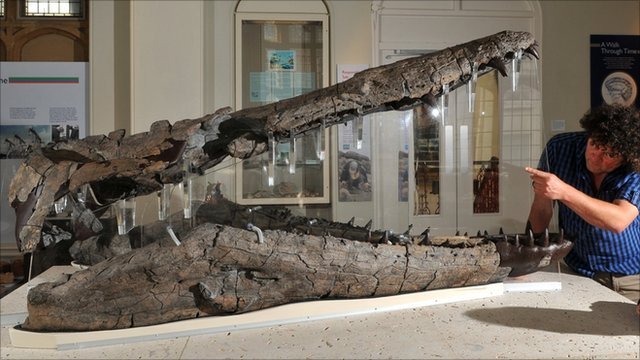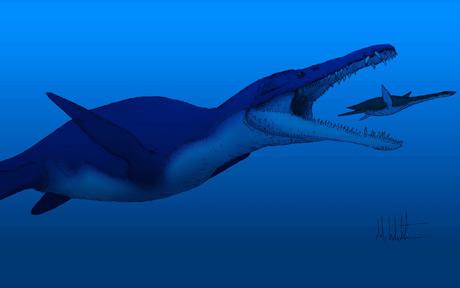The surface of the world's most dangerous carnivore
Fossil skull of one of the most macabre "sea monsters" recently published by scientists in the UK.

The skull fossil of this giant carnivore is on display at the Dorset County Museum, England. Photo: BBC
The BBC says the fossil dating back to 155 million years was discovered by Kevan Sheehan collector in Dorset county, southwestern England from 2003 to 2008 when it gradually emerged from the cliffs.
" I was sitting on the sea and saw 3 pieces of fossils. I have no doubt about them but then I started pulling them out. Every year I come back here and find a new piece of fossil, " said Kevan. .
Mr. Kevan said that at first they looked more like big rocks than a sea monster. It takes up to 18 months for scientists to remove all the surrounding shells, revealing the special details of the monster's skull. This skull is 95% complete and can be the largest and best preserved skull fossil in the world.
Fossils show that this mammal has a formidable power similar to the most terrifying predators of the Jurassic or Cretaceous era. They have large eye sockets near the top of the head, any prey can be observed. The mouth cavities show extremely powerful jaw muscles along with huge, sharp, razor-sharp teeth that help them swallow anything that stands in the way. Based on the 2.4m skull, the scientists estimated that this animal has a length of 15-18m from the top of the head to the tail.

The fossil of this animal's skull shows it to be one of the largest and most dangerous sea monsters. Photo: BBC
" Maybe this is the most dangerous carnivore that ever existed on earth. Standing in front of the fossil of the skull, you feel like this monster is staring at you and preparing to attack you, " said the student. the subject Richard Forrest said.
The fossil was purchased by the Dorset County Museum's Heritage Lottery Fund for $ 32,000, half of which belongs to the collector and the other half belongs to the landowner who found the fossil.
There is still much controversy surrounding the question of whether this is the largest carnivore in the world. Scientists think it is difficult to find the complete fossil of this beast, while larger specimens were found in Oxfordshire. Recent discoveries at Svalbard and the " Aramberri beast " found in Mexico are also candidates for the world's largest carnivorous beast title.
- The truths always amaze you about the biological world
- France blocks 'gate connecting the worlds'
- Discovering many cosmic mysteries, people yearn to find new worlds
- The universe is full of earth
- The mystery behind the world's most dangerous object
- In 2012, the United States will be inundated with storms
- Detailed 3D map of the Moon's surface
- The surface of the Sun is not as hot as you think
- Mystery of life beneath the surface of Mars
- Video: The dead surface of the sun
- Successfully fabricated surface against water
- Close up of Mars surface
 Discovered an ancient centipede fossil 99 million years old
Discovered an ancient centipede fossil 99 million years old Discovered bat-like dinosaurs in China
Discovered bat-like dinosaurs in China Discovered a 200-year-old bronze cannon of the coast
Discovered a 200-year-old bronze cannon of the coast Discover 305 million-year-old spider fossils
Discover 305 million-year-old spider fossils